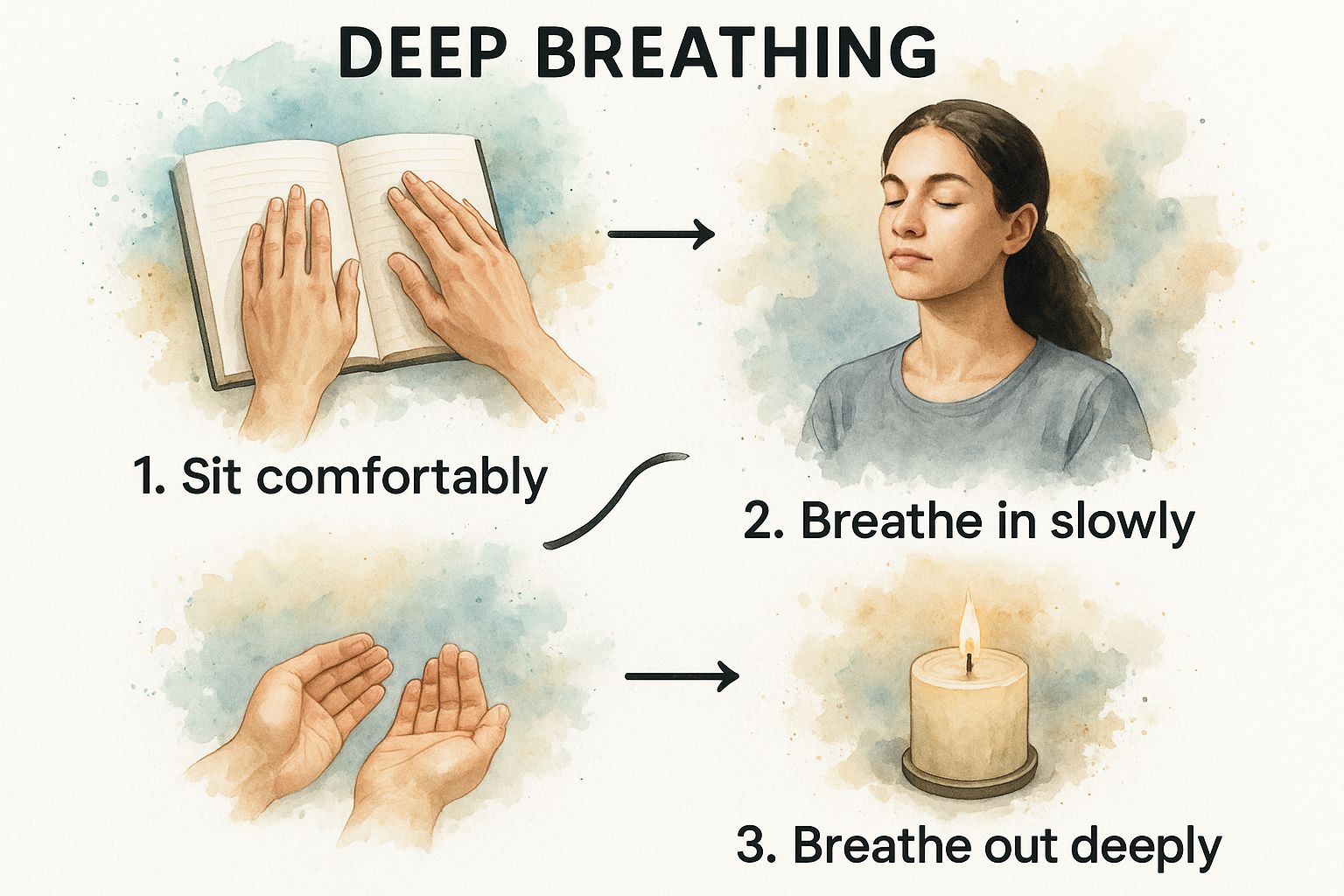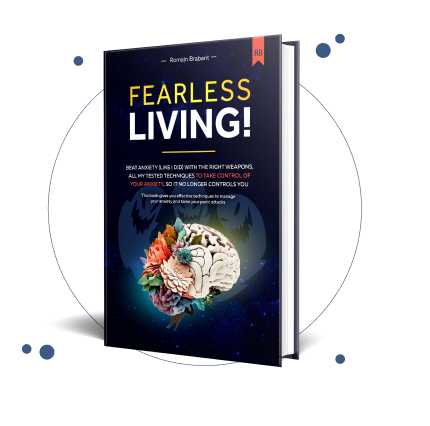
You know those quiet moments right before sleep, the ones that are supposed to bring peace? For many of us, they do the exact opposite, triggering a sudden rush of anxiety at bedtime. This isn't just a random worry; it's a real, physiological response where a calm mind suddenly gives way to racing thoughts and a pounding heart.
Getting a handle on this pattern is the first real step toward taking back your nights. And you absolutely can. Living a life free from panic and filled with peaceful sleep is not just a dream—it's an achievable reality.
Why Anxiety Spikes When Your Head Hits the Pillow
It’s a frustratingly common story. After a long day of work, chores, and endless distractions, you finally lie down to rest. The external noise fades, the room goes dark, and bam—your internal world roars to life. This isn't a sign that you're weak or failing at relaxation; it’s a predictable pattern of how the human brain works, and one you have the power to change.

During the day, your mind is occupied. It’s juggling tasks, conversations, and all the stimuli from your environment, leaving very little room for unprocessed worries to come to the surface. Bedtime creates a vacuum. With nothing external to focus on, your brain turns inward, and any anxieties you successfully pushed aside during the day can rush in to fill that silence.
The Shift from External to Internal Focus
Think of your daytime mind as a busy traffic controller, directing thoughts and actions from one place to another. But at night, that traffic controller goes off duty. Suddenly, all the "cars"—worries about work, finances, relationships, or your health—start moving at once without any direction, creating a massive mental traffic jam.
This internal chaos can actually trigger your body’s stress response, what we know as the fight-or-flight mechanism. Your brain misinterprets these racing thoughts as a genuine threat and starts releasing adrenaline and cortisol. The result?
- A racing heart just as you’re trying to slow down.
- Shallow breathing that makes you feel even more tense.
- A feeling of being "on alert" when you should be powering down for the night.
Understanding this biological process is empowering. It means your body is doing exactly what it's designed to do—it's just doing it at the wrong time. This insight is crucial because it shifts the narrative from "What's wrong with me?" to "How can I work with my body to feel safe at night?"
You Are Not Alone in This Journey to Peace
If you experience anxiety at bedtime, you are in immense company. According to ResMed's 2025 Global Sleep Survey of over 30,000 people, roughly one-third of adults have trouble sleeping at least three nights a week.
And what are the top reasons they cited? Stress (57%) and anxiety (46%). It just goes to show how widespread this issue really is.
The most important thing to remember is that healing is possible. By understanding why this happens, you can start using strategies that truly work to retrain your nervous system. Simple but powerful practices can help soothe your mind and body, paving the way for a panic-free life. It all starts with the belief that you can change this pattern, one peaceful night at a time.
Turn Your Bedroom Into a True Sleep Sanctuary
Your environment sends powerful signals to your brain. If your bedroom is a place for late-night work, doom-scrolling, or replaying your worries, your mind learns to associate it with stress. You’re essentially training yourself to be anxious in the one place you should feel most at peace.
Transforming your bedroom from a source of anxiety into a genuine haven for rest is one of the most practical—and hopeful—steps you can take to reclaim your nights.
This process goes far beyond just dimming the lights. It’s about creating intentional boundaries that fiercely protect your peace. One of the most effective strategies is to implement a "digital sunset"—a dedicated, non-negotiable screen-free period of at least an hour before you even think about sleeping. This simple act of self-care helps protect your body's natural production of melatonin, the hormone that signals it's time to power down.
Optimizing Your Physical Space for Calm
Creating a tranquil environment means engaging all your senses in a way that promotes relaxation, not stimulation. Think about what truly makes you feel at ease and start there. It’s about small, tangible adjustments that build a foundation for peaceful sleep.
- Master the Darkness: Even tiny amounts of light can disrupt your sleep cycle. To truly signal to your body that it's time to rest, consider installing blackout shades for perfect light control. They make a world of difference.
- Find Your Ideal Temperature: A cooler room, typically between 60 and 67 degrees Fahrenheit (15 to 19 degrees Celsius), is generally considered ideal for sleeping. Experiment to find the sweet spot that feels most comfortable for you.
- Introduce Calming Scents: Aromatherapy can have a powerful effect on your mood. A diffuser with a few drops of lavender or chamomile essential oil can help soothe an anxious mind and create a peaceful atmosphere.
This isn't just about personal comfort; it's a global issue. Recent data highlights a worrying decline in sleep quality worldwide, often linked directly to rising stress levels. A 2025 Sleep Cycle report, which analyzed over 105 million nights of sleep, found that global average sleep quality dropped by 0.46% in just one year, with anxiety being a major contributor. You can discover more insights from the global sleep trends report on SleepCycle.com.
Reclaim Your Bed with Stimulus Control
One of the most powerful psychological principles for combating bedtime anxiety is stimulus control. The concept is beautifully simple: your bed should only be used for sleep and intimacy. That’s it.
By reserving your bed for rest, you retrain your brain to create a strong, automatic association between your bed and a feeling of peace. Over time, simply getting into bed will become a powerful cue for your body and mind to relax and prepare for sleep.
If you find yourself lying awake for more than 20 minutes, get up. Go to another dimly lit room and do something quiet and calming—read a physical book, listen to soft music—until you feel sleepy again. This simple rule breaks the frustrating cycle of tossing, turning, and worrying in the one place you’re supposed to feel most secure.
Every small adjustment you make to your bedroom is a step toward healing. It’s a declaration that your rest is important and that you have the power to create a space that supports your well-being, paving the way for calm, panic-free nights.
Practical Techniques to Calm a Racing Mind
When you’re lying in bed with a racing heart and thoughts spiraling out of control, you need more than just theory—you need practical, in-the-moment tools. The good news? These tools exist, they are incredibly effective, and they are your first step toward proving you can heal from this.
You absolutely have the power to gently guide your mind away from those anxious loops and back to a state of calm. This isn't just about getting immediate relief; it's about building real hope for a panic-free future.
Think of these methods as a mental first-aid kit. They might feel a bit awkward at first, but with a little practice, they can become second nature. You’re not trying to forcefully stop the anxiety; you’re learning to respond to it with compassion and skill, building a new relationship with your own mind.
This image shows a simple flow of calming actions you can take, moving from journaling your worries to practicing mindful breathing—a gentle path from anxiety to peace.

By getting your thoughts out onto paper and then using your breath to soothe your nervous system, you create a powerful one-two punch against nighttime anxiety.
Externalize Your Fears With a Worry Journal
One of the most powerful ways to handle bedtime anxiety is simply to get the worries out of your head and onto paper. A Worry Journal is a simple but profound technique. Before you even think about getting into bed, set aside 10-15 minutes to write down everything that’s on your mind.
Don’t edit or judge your thoughts. Just let them flow freely, no matter how irrational they might seem.
- Write down your specific fears about tomorrow.
- List any tasks on your to-do list that are causing stress.
- Explore the "what if" scenarios that keep circling in your head.
This act of writing does two crucial things. First, it acknowledges your concerns, signaling to your brain that they’ve been "heard." Second, it creates distance. The worries are now on the page, not just swirling inside you, which almost always makes them feel much more manageable. This is an act of taking control.
Challenge Your Thoughts With Gentle Reframing
Once your worries are down on paper, you can start to gently question them. Thought Reframing isn't about pretending your fears don't exist; it’s about looking at them from a more balanced and hopeful perspective. Anxious thoughts love to exaggerate and focus only on the worst-case scenario.
For each worry you've written down, ask yourself a few straightforward questions:
- Is this thought 100% true? Often, you'll find your fear is just a possibility, not a certainty.
- What's a more likely or positive outcome? Challenge yourself to imagine things actually going well.
- What’s one small, actionable step I can take tomorrow to address this? This immediately shifts your focus from helpless worrying to proactive problem-solving.
This process helps break the cycle of catastrophic thinking. Over time, it proves to your mind that you are capable of handling challenges, which builds a deep sense of resilience and calm, essential for a panic-free life.
Activate Your Body’s Relaxation Response
Your mind and body are deeply connected. When your thoughts are anxious, your body follows suit with a rapid heartbeat and shallow breathing. But the reverse is also true—by calming your body, you can calm your mind.
Here are a few tried-and-true techniques that can make an immediate difference when you're feeling overwhelmed at night.
| Technique | What It Does | How to Do It |
|---|---|---|
| 4-7-8 Breathing | Activates the body's natural relaxation system (parasympathetic nervous system). | Inhale through your nose for 4 seconds, hold your breath for 7 seconds, and exhale slowly through your mouth for 8 seconds. Repeat 3-5 times. |
| Grounding | Pulls your attention out of anxious thoughts and into the safety of the present moment. | Focus intensely on a physical sensation. Notice the weight of your blanket, the softness of your pillow, or the feeling of the mattress supporting you. |
| Progressive Muscle Relaxation | Releases physical tension that often comes with anxiety. | Starting with your toes, tense a muscle group for 5 seconds, then release it completely. Work your way up your body, one group at a time. |
These simple exercises are your path back to a state of calm, helping you interrupt the anxiety cycle right when it starts.
The 4-7-8 Breathing exercise, for instance, is a classic for a reason: it just works. It directly activates your parasympathetic nervous system, the part of you responsible for rest and relaxation.
The simple, rhythmic nature of controlled breathing sends a powerful signal to your brain that you are safe. It interrupts the fight-or-flight response and allows your body to return to a state of equilibrium, making it one of the fastest ways to soothe bedtime anxiety.
To dive deeper into this and other powerful methods, you can explore our detailed guide on breathing exercises for anxiety.
Grounding is another incredibly simple but effective method. It pulls your attention out of the chaotic future scenarios in your head and anchors you firmly in the safety of the present. These techniques are your path to taking back control and healing, one calm breath at a time.
Build a Hope-Fueled Bedtime Routine
Fighting anxiety in the heat of the moment is one thing, but creating lasting peace means getting ahead of it. This is where you shift from reacting to anxiety to proactively preventing it. How? By building a calming, predictable routine that tells your mind and body the day is officially over and it’s safe to power down.
This isn’t about adding another stressful checklist to your day. It’s about creating a personal ritual—something you look forward to that’s filled with self-compassion. This is a foundational practice for anyone committed to healing.

The goal here isn't perfection. It's consistency. It's about showing up for yourself, even when you don't feel like it. A solid routine acts as a buffer between the chaos of your day and the quiet of the night, making that transition less jarring for an already taxed nervous system.
For an anxious mind, this kind of predictability is incredibly comforting. Over time, these simple actions become powerful cues that train your brain to wind down, stopping bedtime anxiety before it even has a chance to start.
Create Your Personalized "Menu" of Calm
There's no magic, one-size-fits-all bedtime routine. What feels deeply relaxing to one person might feel like a chore to another. So, instead of forcing yourself to follow a rigid list, think of it as choosing from a "menu" of soothing activities that actually sound good to you.
Your only job is to pick a few things that feel genuinely nourishing.
- Gentle Movement: Try 5-10 minutes of light stretching or yin yoga. This is a great way to release the physical tension that builds up in your shoulders, neck, and back throughout the day.
- Mindful Listening: Put on a calming podcast, a guided meditation, or an audiobook with a narrator whose voice you find soothing. This gives your racing mind something gentle to focus on other than its own worries.
- Analog Reading: Seriously, step away from the screens. Pick up a physical book. Fiction is especially good for this, as it pulls you into another world and offers a healthy escape from your own head.
- Creative Expression: Spend a few minutes with a journal, a sketchbook, or even a coloring book. These activities engage a different part of your brain and can be incredibly meditative.
The real power of a routine is in its consistency. When you repeat these calming actions night after night, you’re actively rewiring your brain's response to bedtime. You're replacing the old, worn-out pathway of anxiety with a new one of peace and safety.
A Sample Hope-Fueled Routine
To give you an idea of how this could all come together, here’s a simple routine that works for many people. Think of this as a template—the best routine is the one you customize for yourself.
- 9:00 PM – Digital Sunset: All screens off. No more scrolling. This is a non-negotiable act of self-care.
- 9:15 PM – Prepare for Comfort: Change into your favorite cozy pajamas. Make a warm, caffeine-free drink like chamomile tea or a golden milk latte.
- 9:30 PM – Gentle Unwinding: Settle in for 15-20 minutes with that physical book or a relaxing podcast.
- 9:50 PM – Short Meditation: Do a quick 5-minute guided mindfulness meditation to bring yourself into the present moment and let go of the day.
This whole process is a cornerstone of recovery. By intentionally building these small, hopeful habits, you’re taking real, tangible action toward a more peaceful life. To see how this fits into the bigger picture, you can explore all the key anxiety recovery steps that pave the way for lasting change.
When to Seek Professional Support for Your Sleep
All the self-help strategies in the world are fantastic tools, but sometimes, you need a guide. Knowing when to reach out for professional support isn't a sign that you’ve failed—far from it. It's a brave, empowering step toward taking back control and finding lasting healing.
Sometimes, what feels like simple nighttime worry is actually tied to a bigger, highly treatable condition like an anxiety disorder or chronic insomnia. Reaching out gives you access to proven therapies that get to the root of your sleep struggles, lighting a clear path to panic-free nights.
The Power of Guided Treatment
One of the most effective, evidence-based treatments out there is Cognitive Behavioral Therapy for Insomnia (CBT-I). This isn't just about managing symptoms. It’s a structured approach that helps you rewire the very thoughts and behaviors that are sabotaging your sleep. A qualified therapist can guide you through this process with personalized strategies that fit your unique situation.
Recognizing the need for this kind of support is becoming more common as awareness grows. In fact, anxiety at bedtime—sometimes called 'sleep anxiety'—is now a major focus in the wellness world. Experts are increasingly recommending interventions like CBT-I and structured mindful routines as first-line defenses. You can dig into the research on this growing trend at GlobalWellnessInstitute.org.
Remember, the goal isn't just to survive your nights—it's to reclaim them. A therapist acts as a partner in this process, helping you build the skills and confidence to finally get the restorative, peaceful sleep you deserve. You don't have to do this alone.
Finding the right support can make all the difference. These therapies are designed to give you tools that last a lifetime, reinforcing the hopeful truth that you can overcome this. To learn more about how it all works, check out our detailed guide on psychotherapy for anxiety.
Your Questions on Bedtime Anxiety Answered
Pushing through anxiety is a journey, and it’s natural for questions to pop up along the way. Sometimes, getting a clear, straightforward answer is all you need to feel confident enough to keep going.
Let's tackle some of the most common concerns people have when they start working on their anxiety at bedtime. Think of this as your go-to guide for those specific sticking points.
What If I Wake Up With Anxiety in the Middle of the Night?
It’s one of the worst feelings—being jolted awake by a rush of panic. Your first instinct might be to fight it, but that usually makes things worse. The best thing you can do is respond with a plan, not panic.
If you’re still wide awake and buzzing with anxiety after 15-20 minutes, get out of bed.
Go to another room, keep the lights dim, and do something mind-numbingly boring. Read a dense textbook or listen to some quiet, calming music. The key is to stay off your phone. This simple act starts to break the connection your brain is forming between your bed and that feeling of anxious alertness. Head back to bed only when you feel genuinely sleepy again.
Can Certain Foods or Drinks Make My Bedtime Anxiety Worse?
Absolutely. What you eat and drink has a direct line to your nervous system, and making smart choices is an empowering part of your healing journey.
Caffeine is the most obvious offender. It can hang around in your system for up to 10 hours, so that afternoon coffee could be the reason you're wide awake at midnight. It’s a good rule of thumb to cut it off after 1 p.m.
Big meals or sugary treats right before bed are also a problem, as they can mess with your sleep cycles. And while a glass of wine might feel like it’s relaxing you, alcohol actually leads to fragmented, poor-quality sleep later in the night, often causing you to wake up feeling anxious.
If you're hungry before bed, go for something light and sleep-friendly, like a banana or a small handful of almonds.
Healing from anxiety is a personal journey, not a race. The goal isn't immediate perfection but gradual, consistent progress. Every small victory—even just one slightly easier night—is a meaningful step toward building a new, peaceful relationship with sleep.
How Long Will It Take for These Techniques to Work?
This is the big question, and the honest answer is: there's no magic timeline. And that's perfectly okay. This is a process of healing, not an overnight fix.
Some people feel a difference within a week or two, especially if they make consistent changes to their environment and routine. For others, particularly if you’re working to undo deeply ingrained thought patterns, it might take several weeks to really feel a significant shift.
Your two most powerful allies here are consistency and self-compassion. You're not just trying to survive tonight; you're building skills that will lead to countless peaceful nights in the future. Believe in your ability to heal.
If you want more context on what to expect during your healing journey, learning about different anxiety disorders can offer some valuable perspective.
At The Anxiety Checklist, we believe everyone deserves to live a fearless life. Our system provides practical, action-oriented tools to help you manage anxiety and reclaim your peace. Start your journey toward lasting wellness today. Learn more at https://anxietychecklist.com.

